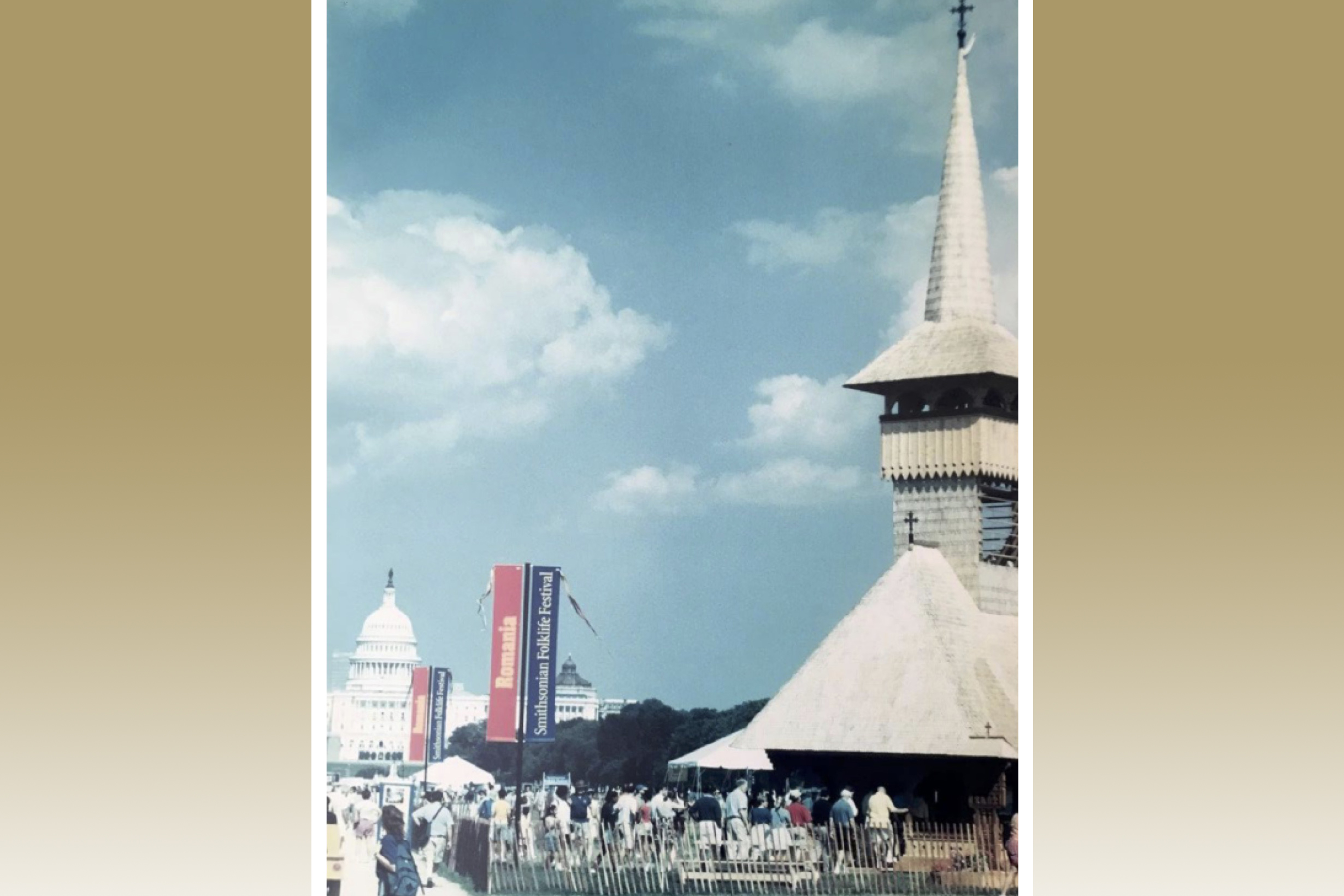In 1999, an impressive structure went up on the National Mall: a wooden church in the traditional Romanian architectural style, imported in pieces and rebuilt over three nights for the Smithsonian Folklife Festival’s “Gateways to Romania” exhibition. The church and the exhibition it anchored were the brainchildren of Eliot Sorel, now a clinical professor of psychiatry and behavioral health sciences in the George Washington University School of Medicine and Health Sciences (SMHS).
“The exhibit was visited by over 1 million people, and through the media more than 40 million people had access to it,” said Sorel, who also holds a part-time clinical faculty appointment of global health, health policy and management in the Milken Institute School of Public Health. “So instantaneously this made quite an impact.”
The 25th anniversary of Sorel’s partnership with the Folklife Festival was honored twice this summer—first in Washington at an event organized by the United States ambassador to Romania, then in Bucharest at an event organized by the Romanian Academy and Babeș-Bolyai University. The latter, “Romania at the Smithsonian Folklife Festival 25th Anniversary Celebration: 1999-2024,” was a two-day celebration featuring an orchestral concert and speakers discussing the exhibition and Romania’s cultural impact on the U.S. more generally.
Sorel could reasonably be called a citizen of the world. Born in Fălticeni while Romania was an Eastern Bloc state, he left the country as a young man with the help of an uncle living in the United States. He first studied in Paris, then moved to the United States to undertake his psychiatric studies at Yale University. His first job as a practitioner was developing a mental health clinic in the context of a family health center in the West Indies. Each culture in which he’s lived has a unique beauty in which he’s been grateful to share, Sorel said—and he’s found reciprocal fulfillment in sharing his Romanian heritage. When his children were in elementary school in Maryland in the early 1990s, Sorel and his wife initiated an “international night” at which families could share favorite foods, music and traditions from their home cultures.
“We had parents from the Americas, from Africa, from Europe,” Sorel said. “And those cultures have an essential contribution to make to all the children's education. Myself, my wife and my kids felt that we should be generous ourselves in sharing our traditions.”
As Sorel tells it, he pitched “Gateways to Romania” out of the blue, cold-calling then-Folklife Festival director Richard Kurin in the mid-1990s to suggest his country’s inclusion. Kurin mentioned that his own mother had been born in Romania; Sorel asked him where, and Kurin named the small city of Fălticeni.
“And I said, well, that’s the town I was born in,” Sorel remembered. “That was kind of a providential coincidence, and he agreed to explore the idea.”
In 1997, Sorel flew to Romania and presented the idea to some potential key collaborators, including then-President Emil Constantinescu. He also made his pitch to the National Museum of the Romanian Peasant, a Bucharest cultural mainstay with the expertise to inform the best possible Folklife Festival exhibition.
“Romanian traditions are deeply rooted in peasant culture,” Sorel said. Authenticity would be a watchword for “Gateways to Romania,” he promised, and museum officials, sensing his sincerity and commitment, agreed to help.
The massive Maramureş-style church that would take center stage on the National Mall was part of that authentic experience, insisted upon by the Romanian team. But it posed a dilemma for the Smithsonian, which was forbidden to include religious artifacts in the Folklife Festival’s displays.
“I had kind of a diplomatic mission to explain that this [structure] was not to proselytize for the Romanian Orthodox Church,” Sorel said. “Rather, the church in Romania is part of our cultural expression.” There would be no services, no evangelizing. Rather, the exhibition would focus on traditional Romanian village architecture, in which the church serves as a physical center for preservation, ritual and even defense. Master builders traveled from Romania to assemble the church and gave presentations on its construction.
The celebrations this summer gave Sorel an opportunity to reflect on how Romania and the United States each benefit from the other’s culture. For the performance portion of the Bucharest commemoration, Sorel chose two rhapsodies by composers who are almost synonymous with their countries: George Gershwin’s “Rhapsody in Blue” and “Romanian Rhapsody” by his older international contemporary George Enescu, to be performed by the Doctors Symphonic Orchestra of Bucharest.
“It gives me great pleasure that the friendship, the partnership of Romania and the United States is solid, is enduring, is prospering and is fulfilling that long-lasting dream for Romanians to count Americans among their loyal allies,” Sorel said.
Sorel said GW, which has a substantial Romanian alumni cohort, is part of that partnership. He sees the university as a potentially major force for global educational collaboration in its third century.
“Culture has intrinsic value and value added for strategic partnerships across all areas of activity—in health, in education, in research,” he said.


